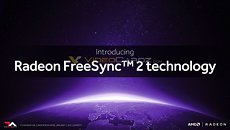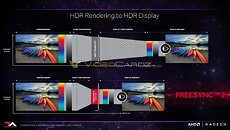Tuesday, January 3rd 2017

AMD Announces Freesync 2 With Expanded HDR Capabilities
But no, bar the name, it doesn't have almost anything to do with AMD's renowned Freesync. Instead, according to Videocardz, AMD are apparently expanding the Freesync functionality to more than just an adaptive synchronization technology - it might eventually become a software stack unto itself, embedded within AMD's drivers. This would be a smart move from AMD, since they would be taking advantage of Freesync's brand and name recognition on the market as a way to promote new features.And what does this "Freesync 2" amount to? Basically, it stands as a way to reduce input lag from HDR processing of an image, by substituting the entirety of the HDR transport and display tone mapping usually needed to render a HDR image by a faster, driver level, Freesync 2 transport (which apparently already includes display tone mapping before the image is sent to the monitor), thus reducing that tone mapping processing time. Another part of the Freesync 2 update is the ability to instantly switch between display modes (SDR and HDR). AMD is also touting Freesync 2 to display "over 2x perceivable brightness and color volume over sRGB", though that honestly looks like more of a byproduct of using an HDR source than a Freesync 2 achievement. We expect to have more information over the coming days.
Source:
Videocardz





18 Comments on AMD Announces Freesync 2 With Expanded HDR Capabilities
If you look at the third picture, conventional HDR transport is replaced by Freesync 2-specific transport which apparently already includes display tone mapping.
a.) competitive perfirmance wise
b.) had fast vsync.
I'm a bios modder. I will never buy Pascal due to a signed-bios model. I WANT an AMD card next, so think of this as feedback, not fanboy criticism.
PS: My monitor IS flicker free and blue light filtered, more reason not to replace it.
I'll admit, it's overkill as fuck. But I don't care, it was too cheap to pass up.
It'll get me past Pascal for now. If NVIDIA continues to lock down their bioses, I'll go AMD next.
PCPerspective explains it.
AMD FreeSync 2 Brings Latency, LFC and Color Space Requirements